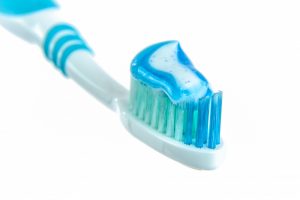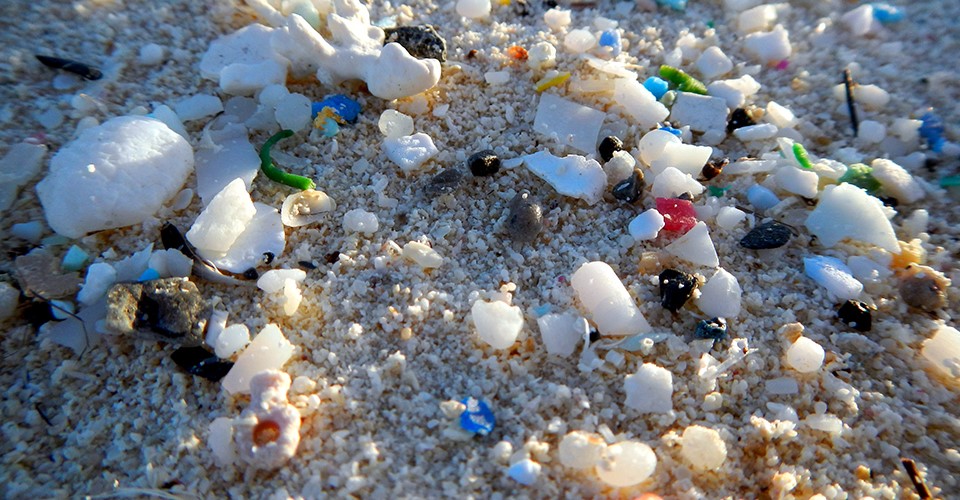Anyone lucky enough to catch any of the BBC’s recent new series Blue Planet II will have noticed that each episode devotes a portion of the time to the impact humans have on the oceans. A breathtaking series of shots from a recent episode detailed the heart-wrenching demise of a baby whale, possibly poisoned by its mother’s milk due to toxins from plastic pollution. Vast quantities of plastic now cover the surface of the ocean, a point the series makes well. We’re now increasingly aware of the risks this plastic introduces, but there’s one part of the problem that scientists have only recently begun to appreciate – so called ‘microplastic’.

Toothpaste is a notorious source of ‘microbeads’.
Microplastic is simply defined as those bits of plastic waste smaller in length than 5mm. This famously includes ‘microbeads’ used in some cosmetics and toothpastes, but there’s also contribution from artificial fabric fibres and degraded bits of larger plastic waste. Because we often can’t see the microplastic with our naked eyes, it goes much more unheralded in contrast to the floating islands of waste bottles and packaging, but that invisibility makes it a more insidious monster.
We still don’t know much about the sources and pollutant pathways associated with microplastic. The United Nations Environment program suggest that cosmetic sources of microbeads have been a pollutant for at least the last 50 years but since then it has often been forgotten as a potential pollutant. In recent years researchers have observed river and ocean sediments in a number of global locations with high levels of microplastic accumulation, while a collaborative investigation between journalists and scientists has revealed that a significant proportion of tapwater in a wide range of urban settings contains measurable microplastic. It seems, then, that this is a problem of growing importance.
The impact for biology is also an emerging subject of study. Microplastic can accumulate either physically in organisms or the toxins generated as it breaks down can poison creatures all across the food chains. Ecologists regularly note the potential for pollutants and toxins to become more concentrated in species further up the food chain, and this is just as true for microplastics. In addition, the plastic compounds have the potential to adsorb other toxins and contaminants onto their surfaces; this mechanism of pollution delivery is poorly understood but considering that the smaller the plastic fragments the greater the proportion of surface area that could be utilised in this way, it could well play a role.
From a sustainability perspective, these plastic fragments could be a timebomb. Not only do they pollute water systems and potentially contribute to poisoning aquatic species, but the impacts could grow for years to come. Even if in the future we shift to a more sustainable model of consumption and production, and recycle the majority of the plastic we use, we will still have to deal with a microplastic legacy of our current plastic use. At present, we have only recycled or incinerated around 20% of our plastic waste meaning that the remaining 80% could disintegrate into fragments over time. It’s clear that understanding how this material enters our water systems and ecosystems is thus of paramount importance.

Microplastic particles on a beach. Image credit: NOAA
And here’s where geologists can play a role. River systems are a topic of interest and study for so many earth scientists, whether geochemists, hydrologists, or geomorphologists. Many geologists routinely sample rivers to analyse the amount of sediment within, or the chemical fluxes. Microplastic fits within the same areas of study; it has been described as a “structural” rather than chemical pollutant – which essentially means it forms part of the solid load of a river – just like regular sediment. Naturally, the physical properties of the plastic differ to sand or clay (the difference in density is particularly important), but the methods we could use to calibrate our microplastic models would be similar to those used to assess suspended or bedload in rivers.
Some scientists are already using these techniques, but much more work needs to be done to effectively understand the long term evolution of the fragments in natural waters. How, for example, do storms and floods affect the storage or mobilisation of microplastic in river sediments? Using hydrological tools to fingerprint the sources of microplastic might also help form a better picture of where exactly these pollutants enter the water systems, which still in many locations remains a mystery. Hydrological models incorporating microplastic transport would certainly help ecologists plan for the impact pollutants would have on aquatic species, and this is exactly what hydrologists could bring to the table.
The adsorption of chemicals to the surface of plastic is similar to other particles in the water flow – particularly colloids. Recent studies have shown that microplastic can adsorb heavy metals (another key set of pollutants) onto their surfaces, and thus deliver these pollutants to a range of species that might ingest the plastic. These are processes well understood by geochemists, offering a chance for the geochemistry community to collaborate with ecologists and conservation researchers.
As with a number of the issues standing in the way of achieving the Sustainable Development Goals, addressing microplastic pollution will require extensive cooperation between scientists of different stripes, policy makers, and polluters. A recent study suggests both that plastics from road wear by cars are the biggest contributor in parts of Europe and that sewage treatment efficiency is an important variable. Resolving these kind of complex infrastructure and ecological problems should certainly engage a cross-section of researchers.
Geologists can find their role in solving this problem as scientists, but importantly as regular citizens too. Limiting plastic use and advocating for recycling are already part of the arsenal of tools we can use to improve the sustainability of our lives; geologists shouldn’t forget that they can contribute in these ways too. Research is still ongoing to understand the range of products and plastics that either contain or form microplastic pollution, but we should all keep track of this research to ascertain how we can minimise our microplastic footprint. We need drinking water more than any other resource, and keeping it unpolluted by tiny plastic particles is an imperative.
Robert Emberson is a science writer, currently based in Victoria, Canada. He can be contacted via Twitter (@RobertEmberson) or via his website (www.robertemberson.com).
